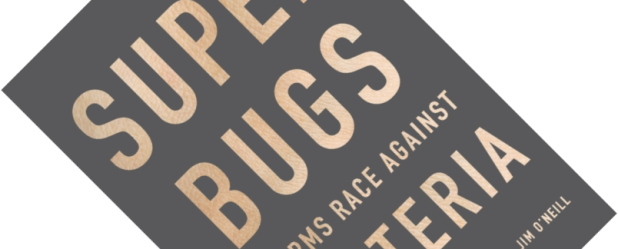Antibiotics have been saving human lives since the drug Salvarsan was discovered in 1932. Penicillin went into mass-production in 1942. This is not a long time when you think about it, but a world without the protection offered by them already seems unimaginable. Not only have they offered protection from diseases such as tuberculosis, and stopped infections following injury or childbirth, they have also allowed us to develop surgical techniques requiring immune system suppression such as organ transplants. However, careless use of antibiotics has accelerated evolution of drug-resistant bacteria such that we are about to lose their protection.

“Superbugs: An Arms Race Against Bacteria“, written by William Hall, Anthony McDonnell, and Jim O’Neill, published by Harvard University Press in April 2018 (hardback, 246 pages)
Superbugs: An Arms Race Against Bacteria is a small book written by two economists and a public policy professional, and follows on their work on the independent Review on Antimicrobial Resistance, which was commissioned by former UK prime minister David Cameron and published in May 2016. The book chronicles the rise of resistant bacteria (you may have seen headlines mentioning MRSA, which is a microbe resistant to methicillin), and why this rise has happened. Part of the failure to develop new antibiotics has to do with the complexity of the science. But far more important are economic and political problems. A combination of the long time required before a drug is approved due to the trials that are needed and the limited duration of patents on these drugs means that it is economically not attractive for pharmaceutical companies to invest in researching new ones.
The second part of the book outlines the solutions proposed by the authors to address this problem. They cover what incentives are required to stimulate drug development, how to prevent disease transmission, how to reduce the use of unnecessary antibiotics in humans, and the need to tackle the abuse of antibiotics in the livestock sector. That last point might come as a surprise to many readers, or so claim the authors. However, I think that animal welfare campaigners have been tabling this topic for long enough for it not to be a particular secret anymore. The reason that the overuse of antibiotics in livestock is so problematic is that these are very similar to the ones used in humans, which means that we are shooting ourselves in the foot – this is another way to encourage evolution of drug-resistant bacteria.
Throughout the book, the authors include quotes and fragments of interviews they have had with scientists and policymakers, providing interesting viewpoints. Lucidly written, the book is far from alarmist, but the situation it sketches is very alarming nevertheless. Whether the solutions proposed here can be put into practice in a timely manner (if at all) remains to be seen. But this is one of those books that you hope will end up in the hands of politicians, for they need to understand the severity of the threat we are facing. One only has to think back to the 2013-2014 Ebola crisis (see Ebola: Profile of a Killer Virus) to realise how difficult it is to control disease outbreaks once they occur. Beyond that group, this book is an excellent primer and overview of the what, how, why, and the “what now” of antibiotics and resistant bacteria that should be widely read.
Disclosure: The publisher provided a review copy of this book. The opinion expressed here is my own, however.

, ebook, audiobook or audio CD
Other recommended books mentioned in this review:


15 comments